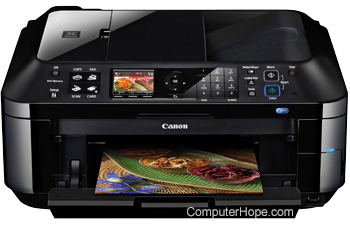How to set up and install a computer printer

A computer printer does not work until you install the included drivers and software. If you lost the CD (compact disc) for your printer, download the drivers for the printer and use them to install your printer. A listing of printer manufacturers and links to their associated driver download pages are on our printer drivers page.
Are all printers the same?
Although not all printers are the same, this page helps with all printer brands (e.g., Brother, Canon, HP (Hewlett-Packard), Lexmark, and Sharp) and their models (e.g., DeskJet, LaserJet, Photosmart, etc.). This page can also help you whether you have an inkjet printer and laser printer.
Connecting the printer to the computer

Connect the printer to the computer either using a USB cable, parallel port cable, or SCSI cable, and then connect the power plug to a power outlet. Today, most home computer printers are using a USB cable similar to the example picture.
If this is a network printer, connect the printer to a wireless network or the RJ-45 connection.
A laptop computer works the same way as a desktop and can use any of the above connections if they are available.
Smartphone and tablet users must have a printer that connects to devices wirelessly or over the Internet to print.
Turning on a printer
After connecting the printer to the computer, it can be turned on using the power button on the front of the printer. Typically, the power button is on the front right corner of the printer. However, the button placement depends on the type of printer you have. Older laser printers may even have a power switch in one of the back bottom corners of the printer.
Setup printer and install software
After connecting the printer and turning it on, you'll need to install the printer's software and drivers. Every printer should come with the software used to install a printer in Windows or your operating system.
- After everything is plugged in, turn on the computer.
- Insert the CD that came with the printer. If the CD does not automatically start, open My Computer, double-click the CD drive, and click the Setup or Install file. If you have downloaded the drivers, run the downloaded setup file.
- Follow the installation wizard, and once completed, your software is installed.
- Test the printer to make sure it is working.
Computer with no CD, DVD, or disc drive
If your computer does not have a disc drive or you lost the CD, download the software for your printer from the manufactures printer's driver page. Once the drivers are downloaded, run the file to install the drivers.
No drivers available for my operating system
Newer operating systems may not support all older printers. For example, Windows 10 may not support a printer that was made years before it was released. If drivers are not listed on a printers' driver page, your operating system or your version of Windows does not support that printer. Try installing an earlier version of operating system drivers and it may work. However, for full support, consider getting a new printer.
Installing a printer only using the drivers
If you want the printer to be installed, but none of the extra programs, only install the printer driver by following the steps below.
A listing of printer drivers and software is on our printer drivers page.
If you have installed the printer doing the steps above, these steps should not be necessary unless you encountered errors.
- Open the Control Panel with the printer connected and powered on.
- In the Control Panel, double-click the Printers or Printers and Fax icon.
- In the Printers window, click the Add a printer icon.
- After completing the above steps, see the Windows Printer Wizard. Click Next to start the wizard.
- Next, you have the choice of installing a Local or Network printer. If the printer connects directly to your computer, choose Local printer attached to this computer and click Next.
- When prompted for the printer driver location, browse to the directory of your drivers or point it to the printer CD.
Does a printer require drivers?
Yes. For a printer to communicate and work with the computer and its operating system, it requires a driver to be installed. In some situations, a generic printer driver included with the operating system may work, but these generic drivers don't always work with all printers.
Although a driver is required, the extra software for the printer is rarely required for the printer to work.
Test the printer
After installing the printer, access the printer settings in the operating system and print a self-test page to help verify the printer is working.
Microsoft Windows users
- Open the Control Panel.
- Double-click the Devices and Printers, Printers, or Printers and Fax icon.
- Right-click the printer you want to test and click Properties. If you do not see your printer, your printer is not installed.
- In the Printers Properties window, click the Print Test Page button.
- If the printer can print a test page, your printer is installed and set up properly. However, if you cannot print in other programs, the program you are attempting to print from has issues.
If the printer can print a test page, your printer is installed and working. Configure other printer settings, as desired, by opening the printer software or the Printers & scanners section in Windows.
